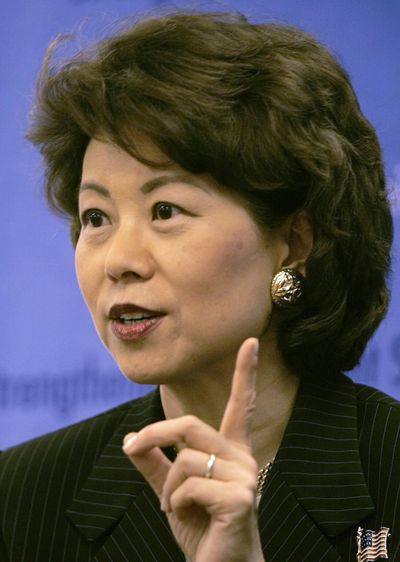Feds rush to alter job-site toxin rules
Critics blast fast-track, quiet approach

WASHINGTON – Political appointees at the Department of Labor are moving with unusual speed to push through in the final months of the Bush administration a rule making it tougher to regulate workers’ on-the-job exposure to chemicals and toxins.
The agency did not disclose the proposal, as required, in public notices of regulatory plans that it filed in December and May. Instead, Labor Secretary Elaine Chao’s intention to push for the rule surfaced July 7, when the White House Office of Management and Budget posted on its Web site that it was reviewing the proposal, identified only by its nine-word title.
The text of the proposed rule has not been made public, but according to sources briefed on the change and to an early draft obtained by the Washington Post, it would call for re-examining the methods used to measure risks posed by workplace exposure to toxins. The change would address long-standing complaints from businesses that the government overestimates the risk posed by job exposure to chemicals.
The rule also would require the agency to take an extra step before setting new limits on chemicals in the workplace by allowing an extra round of challenges to agency risk assessments.
The department’s speed in trying to make the regulatory change contrasts with its reluctance to alter workplace safety rules over the past 7 1/2 years. In that time, the department adopted only one major health rule for a chemical in the workplace, and it did so under a court order.
In an interview, Labor’s assistant secretary for policy, Leon Sequeira, said officials did not disclose their interest in the rule change earlier because they were uncertain until recently whether they wanted to pursue a regulation.
But the fast-track approach has brought criticism from workplace-safety advocates, unions and Democrats in Congress. Some accuse the Bush administration of working secretly to give industry a parting gift that would help it delay or block safety regulations after President Bush leaves office.
“It’s an insult to America’s workers for the Department of Labor to be spending its time in the last year of this administration allegedly fine-tuning the details of how to do these regulations when, other than the one ordered by a court, they have issued no major worker-health regulations,” said Adam Finkel, a professor at the University of Medicine and Dentistry of New Jersey who is a former health standards director at Labor’s Occupational Safety and Health Administration. “The reality is there’s a great need to light a fire under this moribund agency to do something – anything – to protect workers.”
Rep. George Miller, D-Calif., chairman of the House Education and Labor Committee, said: “The fact that the Department of Labor seems to be engaged in secret rulemaking makes me highly suspicious that some high-level political appointees are up to no good. This Congress will not stand for the gutting of health and safety protections as the Bush administration heads out the door.”
Sequeira said department policy prevents him from discussing the details of a draft rule, how it was written and by whom, until it is reviewed by the OMB. The public will have 30 days to critique the draft after it’s published.
Last week, however, the proposal was defended in an opinion piece in the New York Sun written by Diana Furchtgott-Roth, a fellow at the conservative-leaning Hudson Institute. She wrote that it would bring a “rationalized approach” to risk assessments and probably move away from the incorrect assumption in current rules that workers stay in a job, with daily exposure to the same chemicals or toxins, for as long as 45 years.
Furchtgott-Roth did not mention in the article that she was one of the consultants who worked with Labor beginning in September 2007 on a $349,000 outside study of the risk-assessment process.
The OMB has been trying to address the issue of risk assessment since 2006, when it attempted to set new standards governing how a host of federal agencies reach their conclusions. That plan was withdrawn after the National Academy of Sciences called it “fatally flawed” because it lacked scientific grounding.
Early this year, Deborah Misir, a political deputy in Labor’s office of the assistant secretary for policy, worked with the OMB to draft a new risk-assessment rule. A former ethics adviser to Bush, Misir had complained that the department’s assumption of a 45-year working life overstated the risk of exposure.
Typically, before drafting a rule, agency officials consult with staff members, lawyers and outside experts, and sometimes industry and other interested parties. But Misir initially did not consult scientific and workplace-risk-assessment experts in OSHA and the Mine Safety and Health Administration, according to sources briefed on her work.
Misir waited until April to seek comments from the department’s experts. They objected to both the legality and substance of the proposal and recommended that Chao not pursue such a rule, according to the sources.
A few weeks later, when the agency listed regulations “under development or review” in its semiannual agenda, the risk-assessment proposal was not included. But a draft was circulating among a small group of advisers, according to a date-stamped copy obtained by the Post.